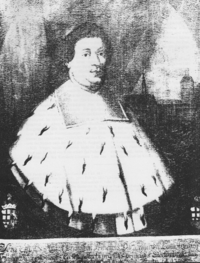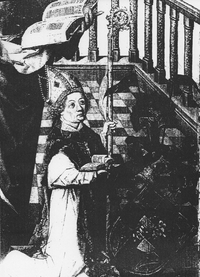Hermann IV of Hesse


.jpg)
Hermann IV of Hesse (German: Hermann von Hessen; "the Peaceful", German: der Friedsame, Latin: Pacificus) (1450–1508) was Archbishop-Elector of Cologne from 1480 to 1508 and Prince-Bishop of Paderborn from 1498 to 1508.
Biography
Early years, 1450–1473
Hermann IV of Hesse was born in Bonn in 1450, the son of Louis I, Landgrave of Hesse and his wife Anna, daughter of Frederick I, Elector of Saxony. As a younger son, Hermann was groomed for the church and received a number of benefices at a young age, including the provost of Aachen Cathedral and Fritzlar Cathedral; Dean of St. Gereon's Basilica; and canon of Cologne Cathedral (in 1461) and Mainz Cathedral (in 1463). He is listed on the register of University of Cologne for 1462 and later studied at the Charles University in Prague.
In 1472, Hermann made a bid to become Bishop of Hildesheim, but was forced to withdraw from the episcopal election after he failed to secure papal recognition. He became diocesan administrator of the Archdiocese of Cologne in 1473.
Role in the Siege of Neuss, 1474–1475
As diocesan administrator of the Archdiocese of Cologne, Hermann was involved in the Cologne Ecclesiastical Conflict (German: Kölner Stiftsfehde) at the time that Charles the Bold launched the Siege of Neuss.
In November 1475, Frederick III, Holy Roman Emperor appointed Hermann Stiftsgubernator.
Archbishop of Cologne, 1480–1508
Hermann assumed control of the administration of the Archdiocese of Cologne following the arrest of Archbishop Ruprecht of the Palatinate in 1478. After Ruprecht's death on 26 July 1480, Hermann was elected as his successor on 11 August 1480. Pope Innocent VIII confirmed his appointment in November 1480.
After many turbulent years, Hermann devoted himself to the administrative and financial recovery of the archdiocese. For the 28 years of peace and stability, Hermann earned himself the moniker of "the Peaceful".
Prince-Bishop of Paderborn, 1498–1508
In 1495, Hermann became coadjutor bishop of the Prince-Bishopric of Paderborn. He was elected Prince-Bishop of Paderborn on 7 March 1498. He set himself against Philip of Cleves, Dean of Strasbourg Cathedral and his brother John II, Duke of Cleves but could not ultimately prevail. Hermann was allied with Maximilian I, Holy Roman Emperor and Pope Alexander VI.
The Reichskammergericht upheld Hermann's jurisdiction over the eastern part of Paderborn. He held a Lehenstag in Paderborn on 1 October 1500 to allow the nobles of Paderborn to pay homage to him. The Reichskammergericht also restored Helmarshausen and Delbrück to the bishop.
Hermann took his role as a spiritual pastor seriously and intensified episcopal oversight of the monasteries. He read mass and prayed the breviary regularly, and performed other episcopal liturgical acts. He arranged for the financing to build the church in Bevern in 1501, and consecrated the church in 1506.
Death
Hermann died on 19 October 1508. He was buried in Cologne Cathedral and his heart was buried in the castle church in Brühl, North Rhine-Westphalia.
References
- This page is based on this page on German Wikipedia.
| Catholic Church titles | ||
|---|---|---|
| Preceded by Ruprecht of the Palatinate |
Archbishop-Elector of Cologne 1480–1508 |
Succeeded by Philip II of Daun-Oberstein |
| Preceded by Simon III of Lippe |
Prince-Bishop of Paderborn 1498–1508 |
Succeeded by Eric of Brunswick-Grubenhagen |